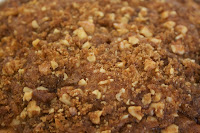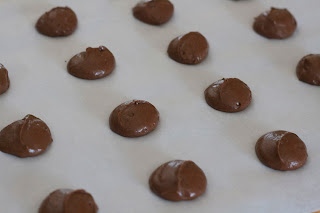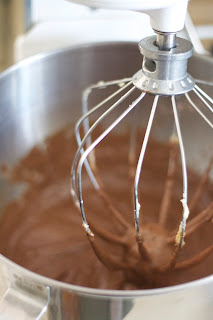For these endeavors, I selected recipes from two of my favorite celebrity chefs whom I feel are among the most reliable sources I've found - Martha Stewart and Alton Brown. I feel confident that I can execute their recipes with good results every time and don't hesitate when their name is associated.
 Love her or hate her, I'm of the belief that Martha's cookie recipes are fantastic. I always look forward to her cookie books and seasonal cookie publications. It was in her Holiday Cookie issue from 2006 that I first found the recipe for Pumpkin Cookies with Brown Butter Icing and I've made them dozens of times since. People always rave about these cookies and I've made them on request countless times, shipping them to friends and family all over the country. They are great anytime of the year, but of course they are especially appropriate for autumn, so it was an easy choice when putting together an offering for my church's bake sale table.
Love her or hate her, I'm of the belief that Martha's cookie recipes are fantastic. I always look forward to her cookie books and seasonal cookie publications. It was in her Holiday Cookie issue from 2006 that I first found the recipe for Pumpkin Cookies with Brown Butter Icing and I've made them dozens of times since. People always rave about these cookies and I've made them on request countless times, shipping them to friends and family all over the country. They are great anytime of the year, but of course they are especially appropriate for autumn, so it was an easy choice when putting together an offering for my church's bake sale table. The Brown Butter Icing is the star of the show. It is a bit of a sophisticated taste - as a child I would not go near cookies with it on them, which is fairly remarkable since I am the original Cookie Monster. Thankfully my tastes have matured and I've done a complete 360 regarding Brown Butter Icing. It adds a nutty, almost maple flavor that is the perfect pairing with the soft cake pumpkin cookies. The instructions call for forming these on the baking sheets with a pastry bag, but I found that using a scoop works just fine. I bagged them up with some cute bags and made up some tags with my scrapbooking scraps, and voila'!
 My husband's birthday cake wasn't such a straight forward selection. I told him I'd make whatever he wanted and when he asked if I knew how to make Red Velvet Cake I said, sure, no problem despite the fact I'd never made one. I've eaten plenty so I figured that qualified me well enough. I have to be honest and say that while generally my baking efforts yield pretty good results, I have at times struggled with layer cakes made from scratch. Technique and timing are really important and like most baking - for me at least - experience and trial and error are the best teachers. Relatively speaking, I've not baked a lot of cakes so consequently my results and comfort level have been a little less than ideal. I needed a no-fail option that did not involve spending $50 at my favorite bakery.
My husband's birthday cake wasn't such a straight forward selection. I told him I'd make whatever he wanted and when he asked if I knew how to make Red Velvet Cake I said, sure, no problem despite the fact I'd never made one. I've eaten plenty so I figured that qualified me well enough. I have to be honest and say that while generally my baking efforts yield pretty good results, I have at times struggled with layer cakes made from scratch. Technique and timing are really important and like most baking - for me at least - experience and trial and error are the best teachers. Relatively speaking, I've not baked a lot of cakes so consequently my results and comfort level have been a little less than ideal. I needed a no-fail option that did not involve spending $50 at my favorite bakery.It didn't take me too long to locate Alton Brown's recipe for Red Velvet cake online. I reviewed it and the accompanying video - which is in the way that only Alton can do entertaining and educational at the same time. This looked to be pretty straight forward with very specific detailed instructions and the online feedback and reviews were all positive so I made my grocery list and got to work.
There are a couple of interesting things about this recipe, at least to my mind. The recipe calls for both all-purpose and cake flour, and brown sugar rather than white, which I don't recall seeing in any cake recipes, at least none that I've used. Because of the red food coloring, extra care is needed when working with the batter as it will stain clothes and dishrags. Alton takes the weight vs. measure approach, so it's best to have a digital food scale when making this cake. He also recommends taking the temperature of the cake to determine doneness which I found much preferable than the typical tester or spring back when touched methods.
As hoped, the recipe was super simple to execute and best of all, the cakes came out moist and very easy to handle with minimal crumb which meant that icing a red cake with white frosting was no problem at all. Friends agreed that the results were delicious. I won't hesitate to make this again and I won't even have to fib about having made it before!
These recipes can be found here:
Martha Stewart's Pumpkin Cookies with Brown Butter Icing
Alton Brown's Red Velvet Cake (Be sure to watch the video!)














































